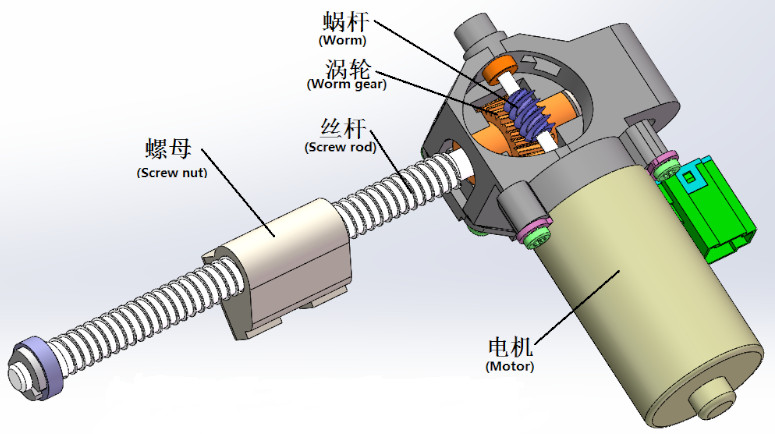The steering wheel adjustment motor, also called the steering wheel position adjustment motor, is a device used in modern vehicles to electrically adjust the steering wheel position. The design of the motor aims to provide drivers with a more comfortable and personalized driving experience, especially, when taking into account different heights and figures of drivers.
Here is some key information about the steering wheel adjustment motor: Window switch motor

The Working Principle of the Steering Wheel Adjustment Motor
Dual Motor System: it usually consists of two motors, one is responsible for adjusting the forward and backward position of the steering wheel, and the other is responsible for adjusting the up and down position of the steering wheel. Thus, the drivers can adjust the steering wheel position according to personal habits and comfort.
Electronic Control: the drivers issue adjustment instructions through the buttons or touch screen interface in the car. After receiving the signal, the electronic control(ECU) unit controls the motor operation to achieve precise adjustment of the steering wheel position.
The User Convenience of the Steering Wheel Adjustment Motor
Electronic Adjustment: compared to traditional manual adjustment, electronic adjustment is more convenient. The drivers only need easy control to finish adjusting, no need to manually pull or turn adjustment levers.
Memory Function: the steering wheel adjustment motor of some advanced models has a memory function that can remember the driver’s preference settings. When the driver enters the vehicle, the steering wheel automatically adjusts to a preset position, providing a personalized driving environment.
The Development of Technology of Steering Wheel Adjustment Motor
Brushless Motor: with the improvement of technology, the brushless motor is gradually becoming the first choice for steering wheel adjustment motors, because of its low noise, high efficiency, and compact design. Compared to the brushed motor, the brushless motor has a longer service life and lower maintenance requirements.
Modular Design: to respond to market demand faster, some suppliers have launched second-generation steering motor products based on modular design. It can preset different modules according to different customer application scenarios, such as the dynamic response module and power density orientation module.
According to a relevant market strategy report, the global vehicles‘ steering wheel adjustment motor market is expected to reach 10 billion dollars in 2024 and reach 15 billion in 2029. The report predicts a compound annual growth rate of 7.5% from 2024 to 2029.
The Major Factors Driving Market Growth Include:
1. The sales of the global automotive is increasing;
2. The consumer demand for comfort and convenience is continuously growing;
3. The standards of vehicles’ safety are more improved;
4. The spread of the EPS system.
By region, Asia-Pacific will be the largest automotive steering wheel adjustment motor market, with the market size expected to reach 4 billion dollars in 2024. Followed by Europe and North America;
By application, passenger cars will be the largest automotive steering wheel adjustment motor market, with the market size expected to reach 8 billion dollars in 2024.
As a vital part of the automotive steering system, the design, manufacturing, and application of the steering wheel adjustment motor are subject to strict industry standards and certification requirements in various regions around the world.

There are Some Industry Standards Information:
United Nations Economic Commission Regulations
UNECE R79 is a unified regulation on motor vehicle steering devices. It covers the general requirements for steering systems, including the structure, performance, test methods, and certification process of steering systems. The regulation is adopted by many countries and regions as the benchmark for steering wheel adjustment motor design and testing.
Chinese National Standard (GB)
GB 17675-2021 “Basic Requirements for Automobile Steering System” is China’s mandatory national standard for automobile steering systems. It stipulates the technical requirements for steering systems, including performance standards for steering wheel adjustment motors. The standard applies to the steering systems of M, N, and O class cars, and puts forward special requirements for electric power steering systems(EPS).
European Standards (EN)
In Europe, steering systems and steering wheel adjustment motors may need to comply with EN standards, which cover everything from materials to performance testing. For example, EN 60950-1 is about the safety requirements for information technology equipment, while EN 60747-2-2 is about the electromagnetic compatibility requirements for electronic equipment.
American Standards
The Society of Automotive Engineers (SAE) has published a series of technical standards on automotive steering systems, including SAE J1010, which is a standard on steering system test methods.
International Organization for Standardization (ISO)
ISO standards also involve automotive steering systems. For example, ISO 26262 is a standard for the functional safety of road vehicles. It provides functional safety requirements for the electronic control unit(ECU) of the steering system.
Different regions may also have specific regulations and standards, manufacturers need to ensure that their products comply with the industry standards requirements of the target market to ensure product safety, reliability, and market access when designing and producing steering wheel adjustment motors.
If you need steering wheel adjustment motor equipment, please feel free to contact us and HONEST Automation will have specialists to serve you.





